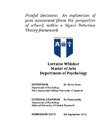| dc.description.abstract | Pain perception is individualistic, subjective and difficult to assess and measure accurately. It is vital for the implementation of appropriate treatment strategies, that healthcare providers and receivers arrive at a similar pain assessment when evaluating a pain experience. The benefits that accrue from mutually derived pain assessment cannot be overstated. These include patients’ well being, appropriate patient care and support, enhanced cost effectiveness of health care systems, and more efficient deployment of available resources. The primary aim of this research is to develop and assess the use of a pain detection and measurement tool within a social communication framework based on Craig’s 2009 Social Communication Model of Pain. The proposed pain detection/measurement tool integrates vignette methodology with a Signal Detection Theory (SDT) framework. The objective is to help explain the under and over estimation of pain commonly observed between healthcare receivers (i.e. patients, individuals etc. who experience pain) and healthcare providers (health practitioners, doctors, nurses, families, carers etc). Existing pain measurement instruments fail to accommodate the social interaction between these two parties. A convenience sample of 660 (i.e. undergraduates n =579; those who have chosen to work in healthcare aka student nurses n =81) judged four pain levels (no pain, mild, moderate and severe pain) experienced by characters depicted in a vignette series that incorporated pain descriptors from McGill Pain Questionnaire (Melzack, 1970) and pain indicators associated with Kehoe et al’s (2007) ‘profile of pain’, (e.g. the distress of pain, physical pain, its influence on suffers, etc). Pain judgement data was subjected to inferential and
SDT analysis. Significant differences were found between groups in their criterion adopted in their pain perception at all levels and between the response-spread across the pain rating scale. Age and gender of characters depicted in vignettes were also found to influence pain judgements differently between groups. Student nurses’ criteria in their pain detection were lower in the no pain condition and higher in the moderate and severe pain condition compared to undergraduates. SDT analysis identified student nurses’ higher pain detection rates compared to undergraduates across mild, moderate and severe pain levels. Differences in willingness to report pain where there were no pain descriptors/indicators were also observed. Benefits of vignettes in clinical settings where both healthcare providers and receivers respond to a similar pain experience are explored. Results fuel a discussion of the use of SDT as an alternative framework for pain detection, assessment and measurement. | en |


